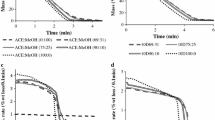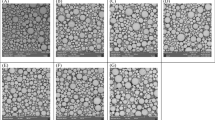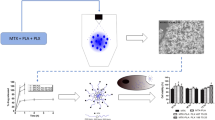ABSTRACT
Purpose
It is imperative to understand the particle formation mechanisms when designing advanced nano/microparticulate drug delivery systems. We investigated how the solvent power and volatility influence the texture and surface chemistry of celecoxib-loaded poly (lactic-co-glycolic acid) (PLGA) microparticles prepared by spray-drying.
Methods
Binary mixtures of acetone and methanol at different molar ratios were applied to dissolve celecoxib and PLGA prior to spray-drying. The resulting microparticles were characterized with respect to morphology, texture, surface chemistry, solid state properties and drug release profile. The evaporation profiles of the feed solutions were investigated using thermogravimetric analysis (TGA).
Results
Spherical PLGA microparticles were obtained, irrespectively of the solvent composition. The particle size and surface chemistry were highly dependent on the solvent power of the feed solution. An obvious burst release was observed for the microparticles prepared by the feed solutions with the highest amount of poor solvent for PLGA. TGA analysis revealed distinct drying kinetics for the binary mixtures.
Conclusions
The particle formation process is mainly governed by the PLGA precipitation rate, which is solvent-dependent, and the migration rate of celecoxib molecules during drying. The texture and surface chemistry of the spray-dried PLGA microparticles can therefore be tailored by adjusting the solvent composition.






Similar content being viewed by others
REFERENCES
Vehring R. Pharmaceutical particle engineering via spray drying. Pharm Res. 2008;25:999–1022.
Delie F, Blanco-Prieto MJ. Polymeric particles to improve oral bioavailability of peptide drugs. Molecules. 2005;10:65–80.
Cook RO, Pannu RK, Kellaway IW. Novel sustained release microspheres for pulmonary drug delivery. J Control Release. 2005;104:79–90.
Alhalaweh A, Andersson S, Velaga SP. Preparation of zolmitriptan–chitosan microparticles by spray drying for nasal delivery. Eur J Pharm Sci. 2009;38:206–14.
Kristen Bowey RJN. Systemic and mucosal delivery of drugs within polymeric microparticles produced by spray drying. BioDrugs. 2010;24:359–77.
Fude C, Dongmei C, Anjin T, Mingshi Y, Kai S, Min Z, et al. Preparation and characterization of melittin-loaded poly (dl-lactic acid) or poly (dl-lactic-co-glycolic acid) microspheres made by the double emulsion method. J Control Release. 2005;107:310–9.
Yang M, Cui F, You B, You J, Wang L, Zhang L, et al. A novel pH-dependent gradient-release delivery system for nitrendipine. J Control Release. 2004;98:219–29.
Chow AH, Tong HH, Chattopadhyay P, Shekunov BY. Particle engineering for pulmonary drug delivery. Pharm Res. 2007;24:411–37.
Shoyele SA, Cawthorne S. Particle engineering techniques for inhaled biopharmaceuticals. Adv Drug Deliv Rev. 2006;58:1009–29.
Kwok PC, Tunsirikongkon A, Glover W, Chan HK. Formation of protein nano-matrix particles with controlled surface architecture for respiratory drug delivery. Pharm Res. 2011;28:788–96.
Iskandar F, Nandiyanto ABD, Widiyastuti W, Young LS, Okuyama K, Gradon L. Production of morphology-controllable porous hyaluronic acid particles using a spray-drying method. Acta Biomater. 2009;5:1027–34.
Tsapis N, Bennett D, Jackson B, Weitz DA, Edwards DA. Trojan particles: large porous carriers of nanoparticles for drug delivery. Proc Natl Acad Sci U S A. 2002;99:12001–5.
Maa YFPS. Biopharmaceutical powders particle formation and formulation considerations. Curr Pharm Biotechnol. 2000;1:283–302.
Saluja V, Amorij JP, Kapteyn JC, de Boer AH, Frijlink HW, Hinrichs WL. A comparison between spray drying and spray freeze drying to produce an influenza subunit vaccine powder for inhalation. J Control Release. 2010;144:127–33.
Mohri K, Okuda T, Mori A, Danjo K, Okamoto H. Optimized pulmonary gene transfection in mice by spray-freeze dried powder inhalation. J Control Release. 2010;144:221–6.
Bi R, Shao W, Wang Q, Zhang N. Spray-freeze-dried dry powder inhalation of insulin-loaded liposomes for enhanced pulmonary delivery. J Drug Target. 2008;16:639–48.
Casettari L, Castagnino E, Stolnik S, Lewis A, Howdle SM, Illum L. Surface characterisation of bioadhesive PLGA/chitosan microparticles produced by supercritical fluid technology. Pharm Res. 2011;28:1668–82.
Salmaso S, Elvassore N, Bertucco A, Caliceti P. Production of solid lipid submicron particles for protein delivery using a novel supercritical gas-assisted melting atomization process. J Pharm Sci. 2009;98:640–50.
Lee YH, Mei F, Bai MY, Zhao S, Chen DR. Release profile characteristics of biodegradable-polymer-coated drug particles fabricated by dual-capillary electrospray. J Control Release. 2010;145:58–65.
Jaworek A. Micro- and nanoparticle production by electrospraying. Powder Technol. 2007;176:18–35.
Jaworek A, Sobczyk AT. Electrospraying route to nanotechnology: an overview. J Electrost. 2008;66:197–219.
Ogain ON, Li J, Tajber L, Corrigan OI, Healy AM. Particle engineering of materials for oral inhalation by dry powder inhalers. I-Particles of sugar excipients (trehalose and raffinose) for protein delivery. Int J Pharm. 2011;405:23–35.
Rizi K, Green RJ, Donaldson M, Williams AC. Production of pH-responsive microparticles by spray drying: investigation of experimental parameter effects on morphological and release properties. J Pharm Sci. 2011;100:566–79.
Baldinger A, Clerdent L, Rantanen J, Yang M, Grohganz H. Quality by design approach in the optimization of the spray-drying process. Pharm Dev Technol. 2011.
Maltesen MJ, Bjerregaard S, Hovgaard L, Havelund S, van de Weert M. Quality by design—spray drying of insulin intended for inhalation. Eur J Pharm Sci. 2008;70:828–38.
Rabbani NR, Seville PC. The influence of formulation components on the aerosolisation properties of spray-dried powders. J Control Release. 2005;110:130–40.
Vehring R, Foss W, Lechugaballesteros D. Particle formation in spray drying. J Aerosol Sci. 2007;38:728–46.
Feng AL, Boraey MA, Gwin MA, Finlay PR, Kuehl PJ, Vehring R. Mechanistic models facilitate efficient development of leucine containing microparticles for pulmonary drug delivery. Int J Pharm. 2011;409:156–63.
Ivey JW, Vehring R. The use of modeling in spray drying of emulsions and suspensions accelerates formulation and process development. Comput Chem Eng. 2010;34:1036–40.
Mezhericher M, Levy A, Borde I. Spray drying modelling based on advanced droplet drying kinetics. Chem Eng Process. 2010;49:1205–13.
Paudel A, Mooter G. Influence of solvent composition on the miscibility and physical stability of naproxen/PVP K 25 solid dispersions prepared by cosolvent spray-drying. Pharm Res. 2012;29:251–70.
Wang F-J, Wang C-H. Sustained release of etanidazole from prepared by non- spray dried microspheres halogenated solvents. J Control Release. 2002;81:263–80.
Giteau A, Venier-Julienne MC, Aubert-Pouëssel A, Benoit JP. How to achieve sustained and complete protein release from PLGA-based microparticles? Int J Pharm. 2008;350:14–26.
Chawla G, Gupta P, Thilagavathi R, Chakraborti AK, Bansal AK. Characterization of solid-state forms of celecoxib. Eur J Pharm Sci. 2003;20:305–17.
Mu L, Teo M-M, Ning H-Z, Tan C-S, Feng S-S. Novel powder formulations for controlled delivery of poorly soluble anticancer drug: application and investigation of TPGS and PEG in spray-dried particulate system. J Control Release. 2005;103:565–75.
Wu JX, Yang M, Berg F, Pajander J, Rades T, Rantanen J. Influence of solvent evaporation rate and formulation factors on solid dispersion physical stability. Eur J Pharm Sci. 2011;44:610–20.
Yarin AL, Brenn G, Rensink D. Evaporation of acoustically levitated droplets of binary liquid mixtures. Int J Heat Fluid Flow. 2002;23:471–86.
Schiffter HA. Single droplet drying of proteins and protein formulations via acoustic levitation. PhD Thesis Friedrich-Alexander-University, Erlangen, Germany.
Wulsten E, Kiekens F, van Dycke F, Voorspoels J, Lee G. Levitated single-droplet drying: case study with itraconazole dried in binary organic solvent mixtures. Int J Pharm. 2009;378:116–21.
Shenoy S, Bates W, Frisch H, Wnek G. Role of chain entanglements on fiber formation during electrospinning of polymer solutions: good solvent, non-specific polymer-polymer interaction limit. Polymer. 2005;46:3372–84.
ACKNOWLEDGMENTS AND DISCLOSURES
This work was funded by The Danish Council for Technology and Innovation via the Innovation Consortium NanoMorph (952320/2009), The Drug Research Academy and The Danish Agency for Science, Technology and Innovation. The authors would also like to thank Erik Wisaeus, Kenneth Brian Haugshøj and Pia Wahlberg (Danish Technological Institute) and Dorthe Ørbæk (Faculty of Health and Medical Sciences, University of Copenhagen) for technical assistance with the SEM, FIB-SEM, XPS and TGA analysis.
Author information
Authors and Affiliations
Corresponding author
Additional information
Feng Wan and Adam Bohr contributed equally to the manuscript.
Rights and permissions
About this article
Cite this article
Wan, F., Bohr, A., Maltesen, M.J. et al. Critical Solvent Properties Affecting the Particle Formation Process and Characteristics of Celecoxib-Loaded PLGA Microparticles via Spray-Drying. Pharm Res 30, 1065–1076 (2013). https://doi.org/10.1007/s11095-012-0943-x
Received:
Accepted:
Published:
Issue Date:
DOI: https://doi.org/10.1007/s11095-012-0943-x




